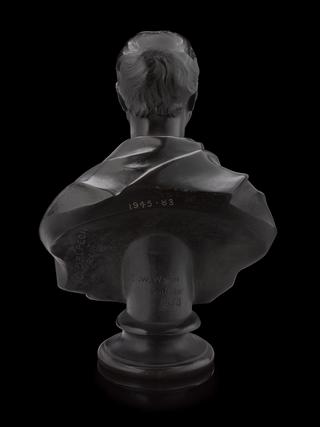
Drawing for Lubetkin's pioneering Finsbury health centre
Architect's drawing 'A Proposed Health Centre Finsbury' by Raymond Myerscough Walker for Berthold Lubetkin of Tecton Architects, 1936. Showing the design for Finsbury Health Centre against a cloudy sky with trees in front and scattered figures. Pencil, watercolours and gouache on cartridge paper. Signed top left 'Myerscough-Walker del 1936', inscribed 'A Proposed Health Centre, Finsbury / Messrs Tecton AARIBA invent'.
A collaboration between far-sighted modernists, artist Raymond Myerscough Walker and architect Berthold Lubetkin, this artwork shows the pioneering Finsbury Health Centre opened in 1938. The Centre anticipated the need for better provision of mass medical treatment and health education 10 years before the birth of the NHS as well as embodying the modernist conviction that architecture could solve social problems.
Berthold Lubetkin left Russia for London in 1931, one of a group of architects in the 1930s who moved to the UK to escape political turmoil in Europe. In 1932, he founded the radical architectural partnership Tecton, which completed the Highpoint apartment block in Highgate by 1935. An early project for a tuberculosis clinic had also attracted the attention of local Finsbury doctor Dr Chuni Katial, who commissioned Lubetkin to design a new health centre in 1936 (on behalf of the Public Health Committee of Finsbury Borough Council). IT was intended to combat the malnutrition and infectious disease common among low-income families in Finsbury. Katial became Mayor of Finsbury in 1938, the UK’s first South Asian mayor.
Finsbury Health Centre demonstrated Lubetkin’s view that ‘nothing was too good for ordinary people’. It was designed to combat multiple social problems in a single, welcoming, public space: dispense treatment, provide health education, and offer temporary housing for the homeless. Specialist clinics included TB, x-rays, vaccinations, a women’s clinic, dentistry, a foot clinic and a solarium. The heart of the centre was a light-filled reception area, walled with glass bricks and approached through gardens, to encourage Finsbury residents to use this as a social space, and combat fear of seeking medical help. Colourful murals by Gordon Cullen encouraged lifestyle choices such as ‘Live out of doors as much as you can’. The approach and messages would become core to the NHS ten years later.
Myerscough Walker was one of the most renowned architectural artists of the 1930s, whose approach gave building designs energy and life with powerful trees and skies, as in this rendering of the Finsbury Health Centre. He worked with Lubetkin for several years, each drawn to the progressive approach of the other’s work. Finsbury Health Centre became particularly associated with a political message that some saw as provocative. Abram Games’ poster ‘Your Britain - Fight For It Now’ from 1943 showed the centre as if on a poster pasted onto the back of a brick wall, a bright future contrasted to the young boy with ricketts who stood in a bombed-out house on the other side. Churchill banned the poster seeing it as negative propaganda.
Details
- Category:
- Art
- Object Number:
- 2021-383
- Materials:
- paper (fibre product), graphite and paint
- Measurements:
-
overall: 390 mm x 640 mm
overall (frame): 540 mm x 785 mm x 18 mm,
- type:
- drawing
- copyright:
- Artist's Estate




